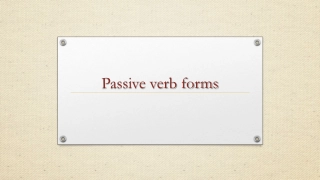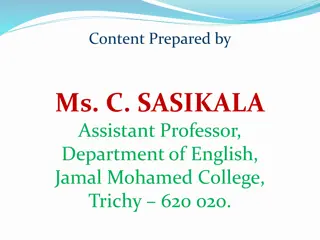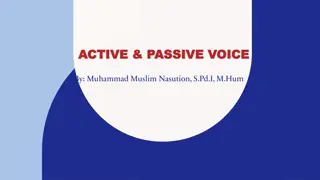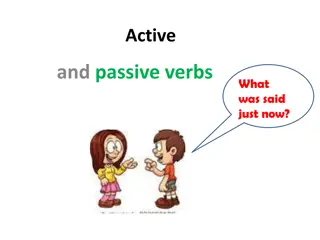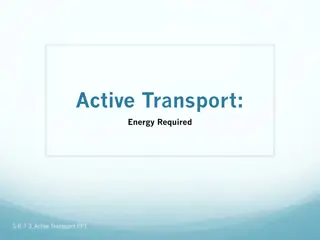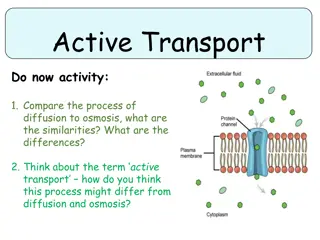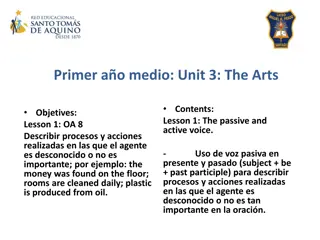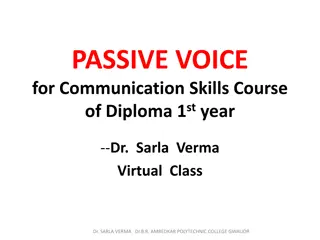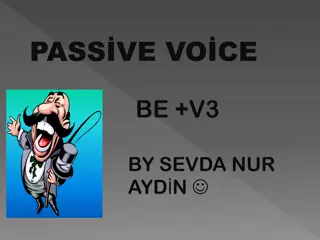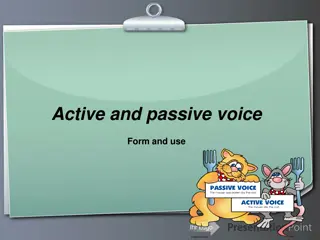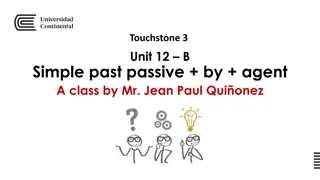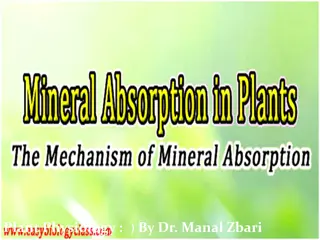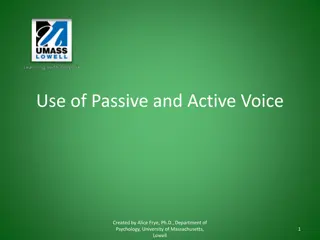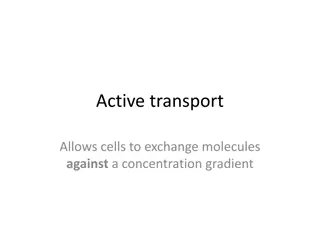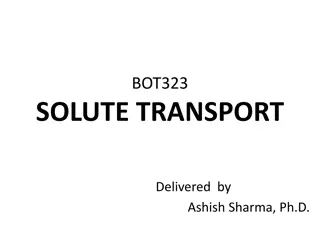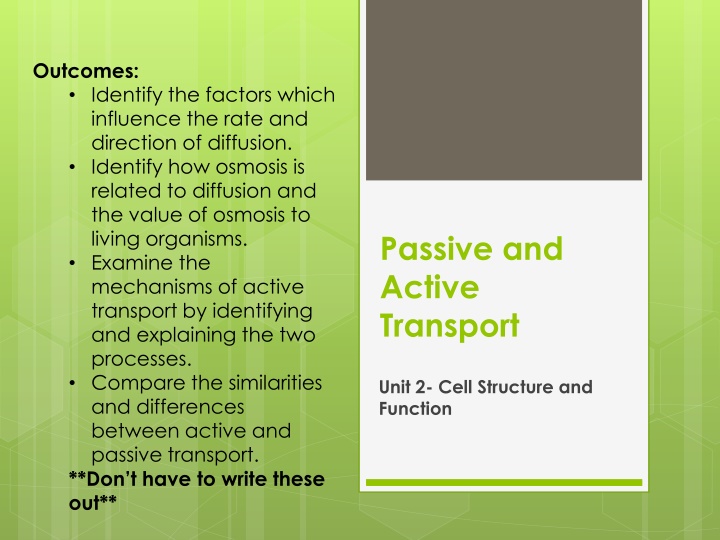
Factors Influencing Diffusion Rates and Directions in Cellular Transport
Explore the factors influencing diffusion rates and directions in cellular transport, the relationship between osmosis and diffusion, mechanisms of active transport, and a comparison of active and passive transport processes. Understand the impact of concentration, temperature, and pressure on diffusion rates.
Download Presentation

Please find below an Image/Link to download the presentation.
The content on the website is provided AS IS for your information and personal use only. It may not be sold, licensed, or shared on other websites without obtaining consent from the author. If you encounter any issues during the download, it is possible that the publisher has removed the file from their server.
You are allowed to download the files provided on this website for personal or commercial use, subject to the condition that they are used lawfully. All files are the property of their respective owners.
The content on the website is provided AS IS for your information and personal use only. It may not be sold, licensed, or shared on other websites without obtaining consent from the author.
E N D
Presentation Transcript
Outcomes: Identify the factors which influence the rate and direction of diffusion. Identify how osmosis is related to diffusion and the value of osmosis to living organisms. Examine the mechanisms of active transport by identifying and explaining the two processes. Compare the similarities and differences between active and passive transport. **Don t have to write these out** Passive and Active Transport Unit 2- Cell Structure and Function
Cellular Transport Cellular transport moves substances _________the cell and moves substances ________and ________of the cell There are 2 types: _________ Transport _________ Transport 1. 2.
Passive Transport These types of transport do not require energy Diffusion Facilitated Diffusion Osmosis a) b) c)
A) Diffusion Remember from years before that particles in solids, liquids, and gasses are in constant ___________ ___________(Particle Theory of Matter) Substances dissolved in water move constantly in random motion The random _________ of these _________ creates DIFFUSION
The amount of a substance in a certain area is called ___________________ Substances diffuse from an area of _________ concentration to an area of _________ concentration Watch the following video and draw the diagram on the next page: http://www.youtube.com/watch?v=Um6O oN81rb4
Diffusion occurs until there is an __________ _______________ of particles in an area/cell The particles continue to move randomly, but there is _____ ____________ ___________ this is called DYNAMIC EQUILIBRIUM
Rate of Diffusion 3 main factors affect the rate that diffusion occurs 1. _______________ When concentration is high, diffusion happens quickly because there are more particles to collide with each other 2. _______________ When temperature increases, the particles collide more quickly 3. _______________ When pressure increases, the particles collide more quickly
B) Facilitated Diffusion While water can diffuse readily across a plasma membrane, most other substances need help Happens through ____________ and _____________ proteins
The CHANNEL PROTEINS in the plasma membrane of the cell are used to diffuse ions and small molecules across the cell membrane (draw the diagram below) http://kentsimmons.uwinnipeg.ca/cm1504/Image132.gif
CARRIER PROTEINS are also used to move substances across a cell membrane by ___________ _________ to help diffusion in a cell (Draw the diagram) http://www.biologyco rner.com/resources/si mpdiff.jpg
C) Osmosis The _________ of water __________ a selectively permeable ____________ is OSMOSIS _____________ the movement of water across the plasma membrane is an important factor in maintaining homeostasis (draw the next diagram)
If the __________________ of solute is higher on one side of the cell membrane, the water will move _____________ the __________ solute __________________ This diffusion happens until dynamic equilibrium occurs
Isotonic Solution When a cell is in a solution that has the same concentration of water and solutes is said to be in an ISOTONIC solution Water moves into and out of the cell at the same rate and cells keep their ______________ ___________
Hypotonic Solution If a cell is in a solution that has a lower concentration of solute, the cell is said to be in a __________________ solution There is more water outside of the cell than inside the cell which causes __________ to move __________ ____ ______ The water moving into the cell creates ___________ ___________
In an ________ cell, the water may enter the cell so much so that it ___________ A plant cell will ________ burst if there is a high osmotic pressure ____________ the cell __________ is very _________
Hypertonic Solution When the ________________ of the solute ____________ of the cell is _______than inside ________ __________ _________ the cell ___________ cells may __________ because of water loss _______ cells ________because the water vacuole is empty
Draw the diagram: http://4.bp.blogspot.com/- yiAZAMJRq4s/Ta79K3vVk8I/AAAAAAAAACE/MhfD0z_ABi8/s1600/ hypo.jpg
Video Explanation http://www.youtube.com/watch?v=AYN wynwaALo
Active Transport This happens when substances have to move from an area of __________ concentration to an area of __________ concentration This process makes sure that cells have the proper ___________ of substances inside of them These forms of cellular transport REQUIRE the use of ______________ by the cell a) Pumps (carrier proteins) b) Endocytosis/Exocytosis
A) Pumps (Carrier Proteins) __________ proteins can move substances against a concentration gradient Some pumps move one type of substance in one direction across the plasma membrane Other pumps move two substances in both directions across the plasma membrane
Sodium Potassium Pump This is a common type of pump moves 3 ___________ ions ______ of the cell moves 2 ___________ ions ______ the cell ATP (a form of energy) _______ _______ into ADP to do this Video demonstration http://www.youtube.com/watch?v=Q73uJ 8WlY_E
http://4.bp.blogspot.com/_207DNIaL- gc/TOaSu8u3q7I/AAAAAAAAAV4/9QLnFO82wQA/s1600/07_16Sodium PotassiumPump.jpg
B) Endocytosis & Exocytosis Particles that are too large to travel through the plasma membrane leave or enter the cell differently
Endocytosis when a cell ______________ something _____________ of the cell The cell membrane __________ ________ and takes the substance inside the cell The substance is now in a __________ to travel throughout the cell
Exocytosis Is when substances ___________ the cell by vesicles ____________ the plasma _______________ to expel (get rid of) the substance

